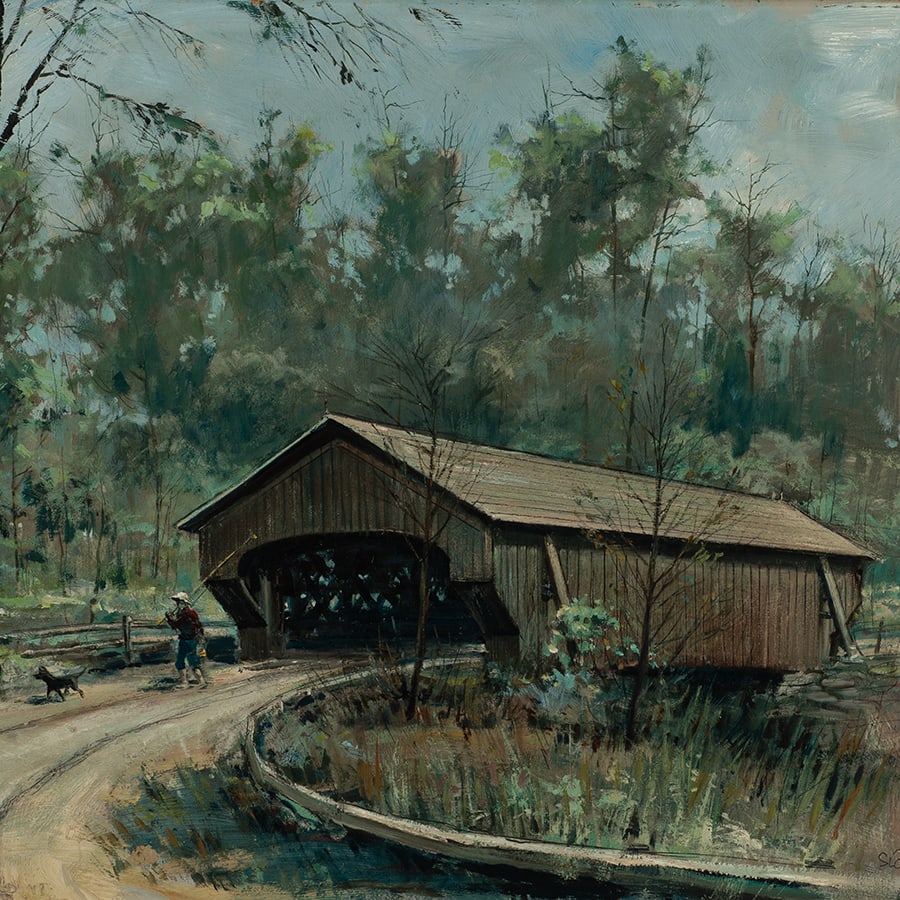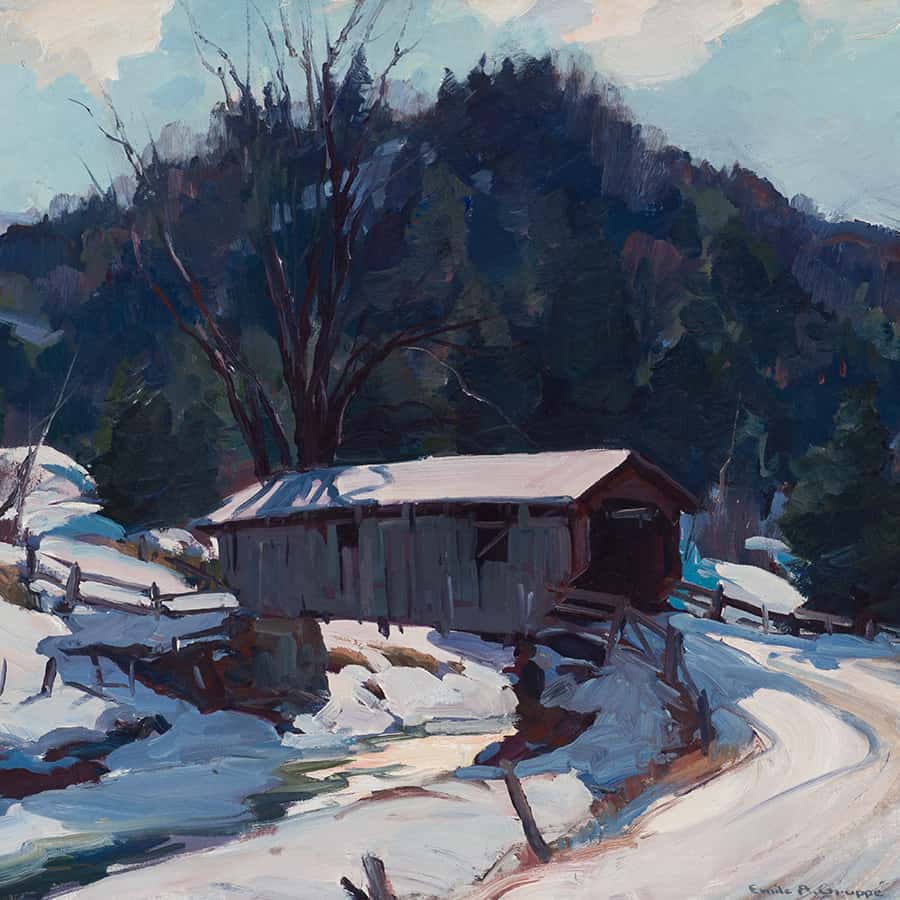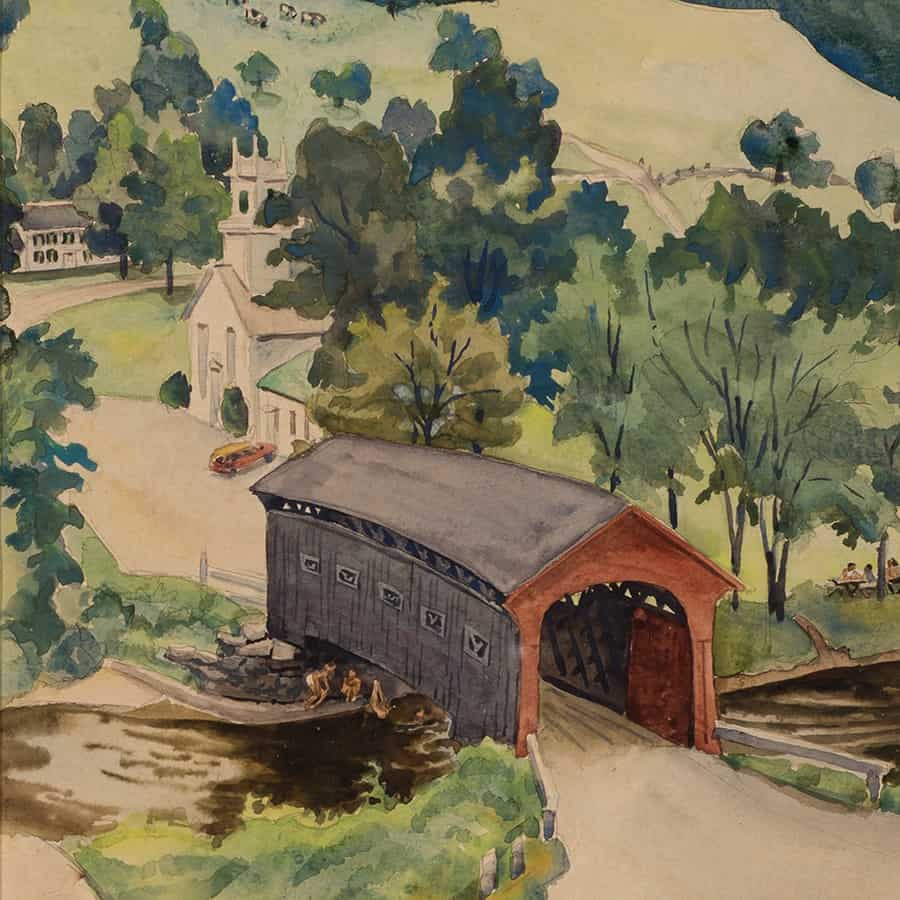Covered Bridges
There is a genteel, old-fashioned pas de deux about the way Vermonters drive across one-lane covered bridges every day on their way to work or school or into town, respectfully taking turns, one at a time, without much of a squabble or the need for a stoplight. The ballet at the portals to Vermont’s covered bridges is a daily performance that has been going on throughout the state for more than two hundred years.
Today, the covered bridges that are still in use in Vermont seem to be in out of the way places, along back roads, spanning scantily watered seasonal streams. The locations make no sense to us now, but with a bit of hard thinking it is possible to put an old bridge into the context of the time it was built.
Excerpt from the book For the Love of Vermont: The Lyman Orton Collection

Black River at Downers, Weathersfield, Vermont
Oil & Graphite on Masonite | 18 x 23 ¾ in.
Eric Sloane (1905–1985)
A prolific illustrator and documentarian, Eric Sloane also wrote and illustrated his own books on topics ranging from weather to farm tools. He was a fine art painter who did wonderful landscapes.
Slone’s given name was Everard Jean Hinrichs. He was born into an affluent family in New York City and ran away at the age of fourteen, earning a living as an itinerant sign painter. Later, he studied at the Art Students League in New York City and at Yale’s School of Fine and Applied Art in New Haven, Connecticut.
The Black River is a tributary of the Connecticut River as it flows through Vermont. After gushing through the gorge at Cavendish, the river slows and widens by the time it reaches Downers Covered Bridge and flows on to Perkinsville. The bridge dates to 1840 and is a Town lattice construction. The 120-foot span was renovated in 2007 and is listed in the National Register of Historic Places.

Vermont Covered Bridge
Oil on Canvas | 25 x 30 in.
Emile Gruppe (1896-1978)
Emile Gruppe did not name this bridge or add a label with its location, but that does not mean it is not a specific bridge in Vermont. The two square openings in the side are possible clues that it might be one of the covered bridges near Gruppe’s winter home in Jeffersonville, a village in the town of Cambridge—it could possibly be the one known as the Grist Mill Bridge, built about 1872 (although that date is disputed). The half-frozen waterway in Gruppe’s painting would be the Brewster River in that case.
Gruppe spent his summers in Gloucester, Massachusetts, where he painted, lectured, and taught at his art school, and it is not entirely a surprise that he painted winter scenes of Vermont in his “off” season. It is one thing to paint the rise and fall of sea and surf, but it is another kind of art altogether to paint snow. Taking a long, slow look at this painting, we see that Gruppe has painted drifted snowbanks, snow on the roof of the covered bridge, and a snow-packed dirt road using almost every color on his palette except black and pure white. His winter home and studio were in Jeffersonville, Vermont.

Covered Bridge, Summer (West Arlington)
Watercolor on Paper | 18 ½ x 12 ½ in.
C. H. DeWitt (1905–1995)
The West Arlington Covered Bridge is an 80-foot-long Town Truss style bridge built in 1852, spanning the Battenkill River. It connects current day Route 313 to the small village of West Arlington, and the bridge is in the National Register of Historic Places.
The West Arlington United Methodist Church, also known as Chapel on the Green, built in 1804 as a non-denominational church, is one of the oldest churches in Southern Vermont. The house seen in this painting, at left center, was the home of famed illustrator Norman Rockwell from 1943 to 1953.
Originally from Germany, Cornelius Hugh DeWitt came to the United States in 1928. He primarily worked as a book illustrator and is known for the artwork he did for many children’s books. The University of Oregon holds an archive of his papers, correspondence, sketchbooks, and artwork.
